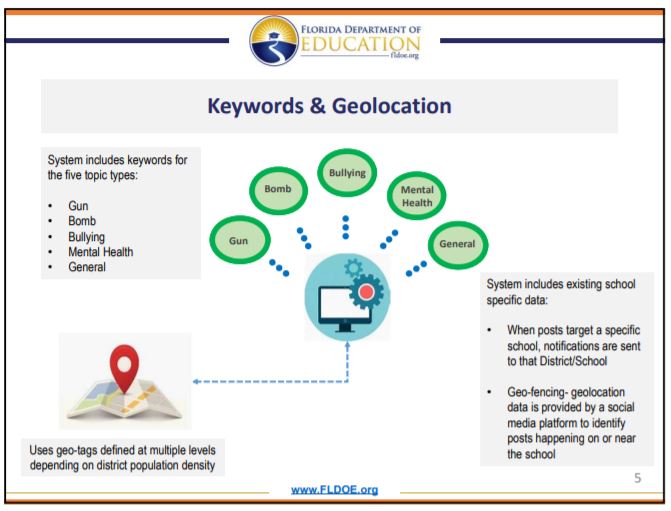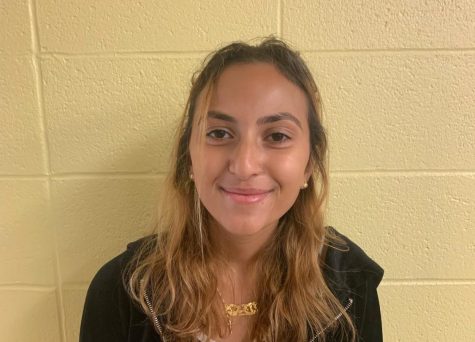The Problem with the Florida School Safety Portal
September 20, 2019
Jamie hits the small icon on her Instagram story, and her video immediately goes out to her followers. The innocent video of her and her friends “shooting hoops” (as the caption states) simmers on her feed as she closes her phone and goes to sleep. The following morning in school, Jamie is unexpectedly called down to the School’s Central Office, where she soon learns she is being investigated. Bewildered, she is informed that the Department of Education’s newly launched program has “flagged,” or notified the state database portal and school district, her as a “potential threat” to those attending the school and to herself.
The Florida School Safety Portal, pending to become a new addition to the Florida Public School System, was created to filter through social media accounts like Jamie’s, tagging account posts that contain threat-connotative words, such as “bombs,” “shooting,” or “guns,” and then locating users within school parameters (a geofence), which have boundaries that have yet to be specified. This tool would allow the school threat assessment teams to identify, assess, and provide intervention services to people who are considered dangerous.
As students in high school, we understand the constant threat of school shootings. We are reminded every morning by the School Resource Officer, Max Werner, who patrols our halls. We know that something needs to be done, but social media monitoring is not the way to go. As teenagers, we are extremely attached to our phones. It is not an unknown fact. We are constantly tweeting, posting, and snapping. Within our constant posts are many opportunities for certain words and phrases to be lost in translation. Some experts worry that the technology is simply not advanced enough to detect these misunderstandings, like in Jamie’s case. What if a student tweets, “I totally just bombed that test!” Even if the examiners immediately recognize this as a false-alarm, the fact still remains that that student just got marked for examination by the system and had his or her personal information exposed to someone.
The proposed portal’s software in its current state is neither advanced nor precise enough to make distinctions between harmless students and those who may be a legitimate threat. Harmless posts will most likely clog the system with pointless information that will distract from real threats, while compromising all students’ privacy and sensitive information. It also has very ambiguous boundaries which have the capacity of being manipulated when placed in vindictive, prying, or malevolent hands.
The intention behind this plan is admirable and a step in the right direction for the issue of gun violence in schools; however, it poses an issue in the protection of the privacy of citizens, amid growing concern that it may be all but gone. Since the alleged Russian interference in the 2016 presidential election and the latest spates of Facebook and Twitter hacks, Internet users are already worried and cautious about online privacy. The fear of being under close scrutiny in one’s online activity only adds additional stress and anxiety to an already-tense scene, with the repeal of net neutrality having happened not too long ago as well. The implementation of a close-monitoring system may only serve to deepen the divide between the people and their government.
To give the plan the benefit of the doubt, there is always a chance, even if a small one, that the administration will catch something on social media of someone threatening the school, students, or teachers. Only a small percentage of posts, however, actually do lead to shootings, like the Parkland shooter’s comment on YouTube. But for the most part, we believe the proposed plan will be ineffective because most perpetrators—considering they should know about this plan—will likely use other forms of communication or even code to convey their threats and messages in an effort to circumvent the system. Perhaps in years to come, when the portal advances, it could be of much aid to schools—that is, when potential threats to the school environment can be assessed to an extent where others are not falsely accused.
Because of all that could potentially go wrong now, however—software breakage due to the influx of fake threats, student protests due to the compromise of privacy, hacking by ill-intentioned individuals—the best course of action is to prevent or at least delay the launch of this software. Cases like the hypothetical Jamie’s aren’t uncommon in our generation, and if the portal is established in the Florida Public School System, it may not be long before it becomes a part of our own public schools. A plan such as this is the first of its kind and marks a new chapter in the technological era. If it gets passed, more states could very well follow in Florida’s footsteps, including New Jersey.
For most of us, social media is about expressing ourselves and connecting with our friends and family. Having to be cautious about everything we post and not being able to use words or phrases we typically use because they would be flagged is a direct violation of our freedom of expression. Would you want your social media compromised?




















































































































































